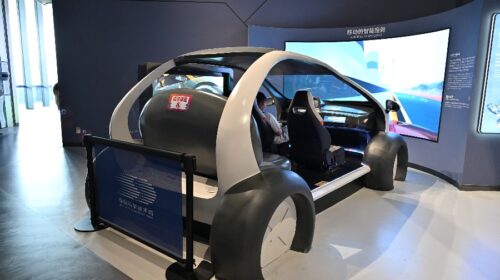With No Chips to Play Against U.S. Sanctions, SMIC’s Margins Tumble

China’s leading semiconductor firm reported disappointing fourth-quarter results and warned its revenue will fall this year as it suffers under the weight of U.S. sanctions
Key Takeaways:
- SMIC reported sequential revenue and profit declines in last year’s fourth quarter, and warned of another 10% to 12% sequential decline in the current quarter
- The company will take a big hit from a recent agreement between the U.S., Japan and Netherlands restricting the sale of DUV lithography machines to China
By Ken Lo
U.S. sanctions continue to bite Chinese chipmakers, which was heavily etched in the latest quarterly results from Semiconductor Manufacturing International Corp. (SMIC, 0981.HK; 688981.SH), China’s largest contract chipmaker. The company reported its revenue fell by 15% sequentially to $1.62 billion during last year’s fourth quarter, marking its first quarter-on-quarter decline in two years. Its net profit also fell 18.1% on the same basis to $386 million.
In addition to feeling the weight of U.S. sanctions, SMIC and its peers are also starting to feel the effects of a looming downturn for the global chip sector, following a boom over the last two years as the world suffered from chip shortages during the pandemic.
SMIC’s annual revenue last year looked far healthier than the latest quarter, rising 33.6% to $7.27 billion, as its net profit also rose by a smaller 6.8% to $1.82 billion. That reflected better times when the global sector was still booming, and effects had yet to be felt from the U.S. “Chips and Science Act,” which was signed into law in August, aimed at boosting the U.S. chip sector at China’s expense.
But SMIC’s latest quarterly story is far more downbeat. Its gross margin fell steadily last year, dropping from 40.7% in the first quarter to 32% by the fourth. Even more concerning, the company said the figure would sag to between 19% and 21% in the current quarter, with the figure settling around 20% for the year, much lower than the 38% for 2022. It added it expects its revenue this quarter to keep falling by between 10% and 12% from the previous quarter.
The company acknowledged being several generations behind its competitors in cutting-edge technologies, and said its expansion plans have faced headwinds from growing U.S. bans on the sale of chipmaking equipment to China. The company’s stock fell by a cumulative 5.3% in the two days after the announcement, reflecting market concerns about its prospects.
Pessimistic outlook
Demand for consumer electronics is waning as economic uncertainties mount worldwide, meaning SMIC’s latest peak may have passed already. CEO Zhao Haijun said on the company’s earnings call that demand for smartphones, computers and household appliances weakened last year. He added SMIC’s clients had stockpiled nine months’ worth of display driver chips, which are used in smartphones and other consumer goods, meaning their appetite for more such chips would be very limited.
Even before the U.S., Japan and Netherlands recently agreed to ban the export of deep ultraviolet (DUV) lithography machines to China, the U.S. had taken a series of its own steps to stymie China’s semiconductor industry. Those included passage of the “Chips and Science Act” last August, which promised $52.7 billion in subsidies and tax credits to eligible fabs around the world on the condition that they could not make any investment in China in the next 10 years. The U.S. also restricts the export of super-computing GPU chips to China, and U.S. citizens, people with U.S. green cards and all employees of U.S. companies aren’t allowed to provide services to Chinese chip companies.
With the combination of weakening demand and U.S. actions hanging over SMIC, it’s no surprise that management was cautious on the company’s 2023 outlook. The company said that the industry would remain mired in a trough during the first half of the year due to external uncertainties. Assuming things stabilize later, the company expects its revenue will register a low double-digit percentage decline for the year.
SMIC expects its capital expenditure this year to match last year’s level, but admitted its gross margin will feel pressure from high depreciation of older machinery as it continues to buy newer equipment. It said its goal is to remain profitable, and noted its projections rely on a relatively optimistic scenario that assumes global chip demand will stabilize and U.S. sanctions won’t intensify.
As China’s leading chip manufacturer, SMIC had hoped to one day take on global leader Taiwan Semiconductor Manufacturing Co. (TSMC, TSM.US, 2330.TW). But given all the western restrictions it now faces, such a plan increasingly looks like a mission impossible. TSMC is the undisputed sector leader, more advanced technologically than other giants like South Korea’s Samsung Electronics (005930.KS) and the U.S.’s Intel Corp. (INTC.US).
Potential for sanctions escalation?
TSMC is racing toward mass production for chips made with 2-nanometer technology in 2025, light years ahead of SMIC, which is still struggling to perfect its 14-nanometer chips. The smaller the technology, the more circuits that can be packed onto a chip’s surface, making it that much more powerful. Despite making much bigger R&D investment and recording higher equipment depreciation than its mainland Chinese cousin, TSMC achieved a mouth-watering gross margin of 59.6% last year, showing how lucrative the high-end of the chip market can be.
The U.S., Netherlands and Japan have yet to release any document on their agreement yet, reflecting flexibilities the U.S. is willing to give to the other two. DUV lithography machines are used in 65 to 110-nanometer process technologies, which is already far from cutting edge. A ban on even less advanced equipment sales to China could have a devastating impact on SMIC and even the whole Chinese semiconductor industry.
Despite the sanctions, SMIC has been able to expand its capacity, with annual capital expenditure totaling $6.35 billion last year. By the end of last year, the company’s had entered production at a new facility in Shenzhen. It had begun trial production at its Jingcheng facility, though mass production is being delayed by a quarter or two due to late delivery of key equipment.
Based on its net profit last year, SMIC’s latest price-to-earnings (P/E) ratio was 9.5 times, lower than TSMC’s 14.6 times. That reflects investor concerns about its outlook in the weaker macro environment, combined with the impact of U.S.-led sanctions and other actions.
To subscribe to Bamboo Works weekly free newsletter, click here






